Nanopesticide Market Research, 2031
The global nanopesticide market size was valued at $0.5 billion in 2021, and is projected to reach $1.6 billion by 2031, growing at a CAGR of 12.5% from 2022 to 2031.Advancements in nanotechnology applications and the rising demand for precision agriculture are significantly driving the growth of the nanopesticide market. Nanotechnology enables the development of innovative and efficient nanopesticides with enhanced targeting capabilities, controlled release mechanisms, and reduced environmental impact compared to conventional pesticides.
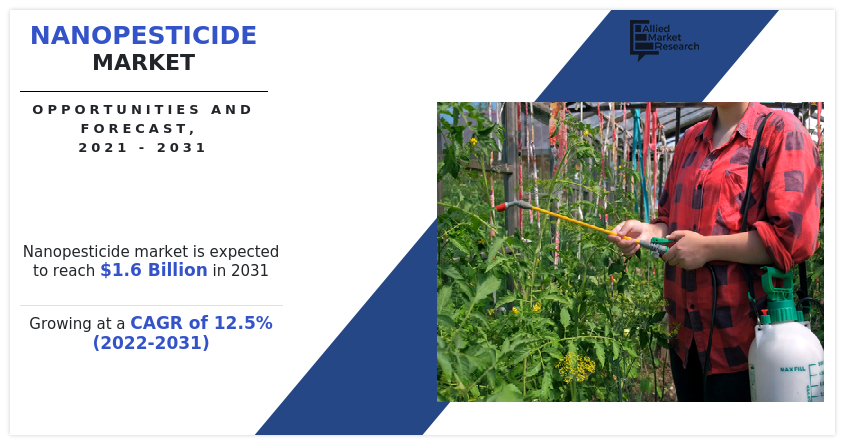 Introduction
Introduction
Nanopesticides are a new generation of pesticides that incorporate nanotechnology to improve their efficiency, targeting, and environmental sustainability. They are engineered using nanoparticles or nanocarriers that allow for controlled release, increased stability, and improved absorption by pests or crops. As compared to conventional pesticides, nanopesticides are designed to minimize adverse environmental effects, such as soil contamination and pesticide resistance, while maximizing their effectiveness in pest control.
Market Dynamics
Advancements in nanotechnology applications are a key driver of the growing nanopesticide market. Nanotechnology enables the development of innovative nanopesticides with enhanced properties such as controlled release, improved stability, and precise targeting of pests. These technological innovations allow for the encapsulation of active ingredients in nanoparticles, ensuring better adhesion, higher absorption, and reduced environmental degradation. As a result, nanotechnology-driven solutions offer more efficient and sustainable pest control options compared to traditional chemical pesticides. All these factors are expected to drive the demand for the nanopesticide market.
Nanopesticides are microencapsulated pesticides that are classified as fungicides, insecticides, herbicides, and others. Nanaopesticides use nanotechnology for plant protection and insect pest control by providing newer and advanced formulations that can penetrate the insect body. The nanopesticide formulations can enhance water solubility, bioavailability, and protect agrochemicals against environmental degradation, revolutionizing the control of weeds, pathogens, and insects in the crops.
Increase in use of nanopesticide in applications, such as pest control and packaging is predicted to drive the market growth during the forecast period. In addition, surge in demand for nanopesticide from the agricultural sector is likely to propel the nanopesticide market growth during the forecast period. However, high costs associated with nanopesticides is anticipated to hinder the growth of the global nanopesticide industry. On the contrary, growing exports of fresh fruits and vegetables is expected to generate lucrative opportunities for the global nanopesticide market.
The nanopesticide market is segmented into type, utility, application, and region. On the basis of type, the market is categorized into nanoinsecticides, nanoherbicides, nanofungicides, and others. On the basis of utility the market is categorized into food crop and industrial crop. On the basis of application, the market is categorized into pest control, packaging, and others. Region-wise, the market is studied across North America, Europe, Asia-Pacific, and LAMEA. The nanopesticide market share is analyzed across all significant regions and countries.
The major players operating in the global nanopesticide market include, Andermatt Biocontrol, Bayer, BioWorks, Inc., Camson Biotechnologies, Corteva, Marrone Bio Innovations Inc, Migrow Agro Solution, Plantix Crop Care, Stockton Biotechnologies, and Valent BioSciences LLC.
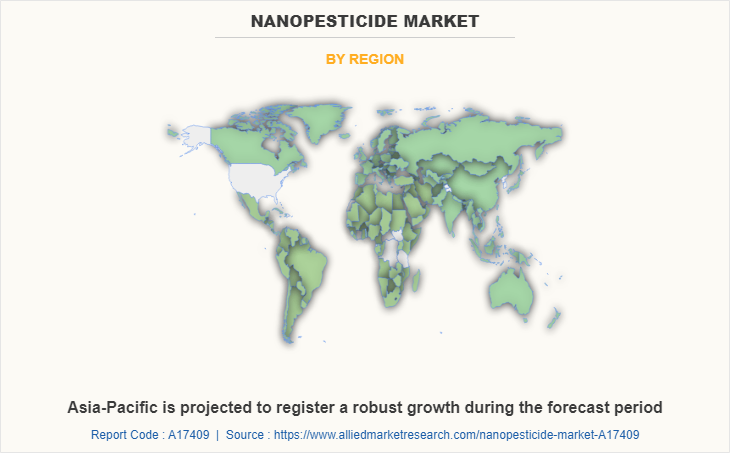
Asia-Pacific is projected to register a robust growth during the forecast period. This growth is attributed to the extensive use of nanopesticides in agricultural products in the region. China and India are known for being the largest producers of cotton. Higher demand for food grains, limited availability of arable land, rise in export, and growth in horticulture and floriculture are also propelling the nanopesticides market in the region.
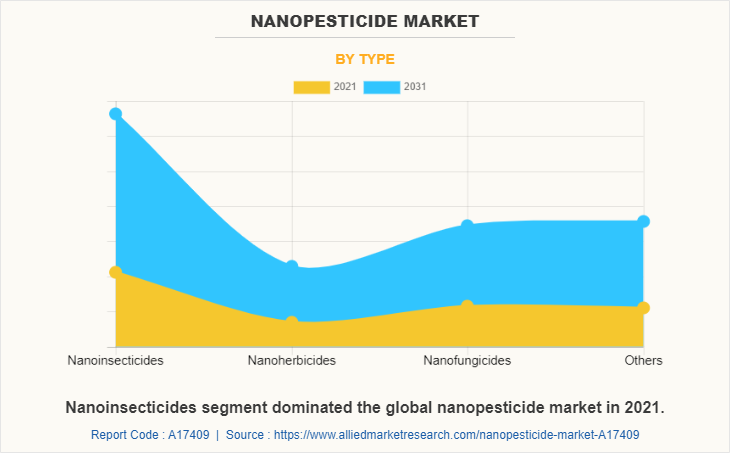
Nanoinsecticides segment dominated the global nanopesticide market in terms of revenue, in 2021. Nanoinsecticides can boost water solubility, bioavailability, and protect agrochemicals from environmental degradation, revolutionizing agricultural disease, weed, and insect management. Nanoinsecticides are nanometer-scale compounds, generally used in the form of nanoparticles that include macro and micronutrients and are given to crops in a regulated manner. These are often targeted at ants and wasps and may be sprayed on insects, applied directly to plants, or put on such exterior surfaces as fences, siding, shutters, and eaves. Such growing demand for nanoinsecticides is expected to boost the nanopesticide market during the forecast period.
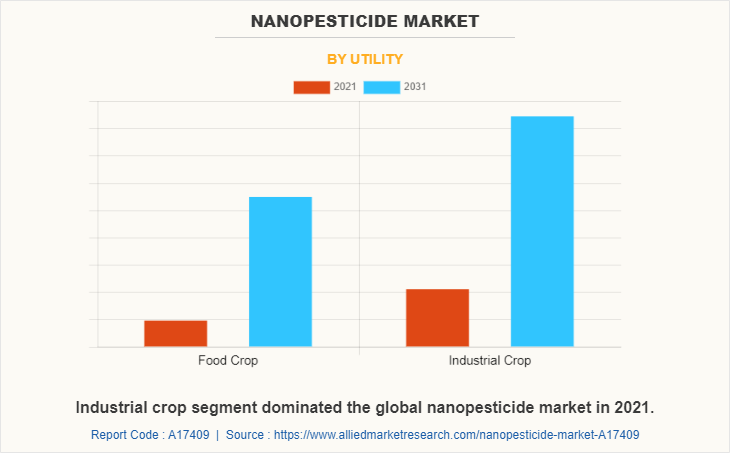
Industrial crop segment dominated the global nanopesticide market in terms of revenue, in 2021. Nanopesticides are used in industrial crops, including cotton, tobacco, and jatropha. Nanopesticides are used in industrial crop as insecticides to kill plant-eating bugs, herbicides to kill weeds and soil fumigants, and fungicides to kill soil-borne diseases. Industrial crops increase productivity and specific chemical components, including sowing, plant density, fertilization, pruning, shading, management of wild stands for sustainable harvest, pests and weed management, harvest, post-harvest, and others. Industrial crop cultivation employed in wasteland phytostabilization, is expected to help improve soil fertility and structure, as well as minimize erosion, leaching, and groundwater contamination. Such growing demand for industrial crops is expected to boost the nanopesticide market during the forecast period.
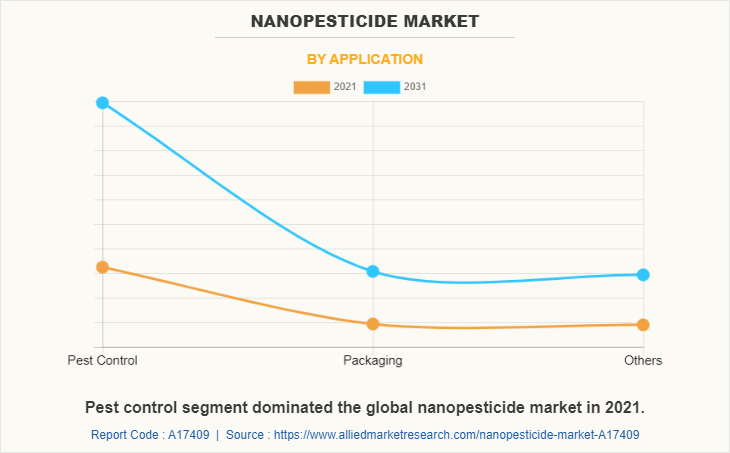
Pest control segment dominated the global nanopesticide market in 2021. Nanopesticides are extensively used to control insects, weeds, fungus, and rodents. Nanopesticides for pest management include, insecticides, herbicides for weed control, fungicides for fungal and mold control, and rodenticides for rodent control. Pyrethrins and Pyrethroids are the most common incesticide pest control substances, which are used as nanopesticides. Such demand for pest control is expected to boost the nanopesticide market during the forecast period.
Key Benefits For Stakeholders
- This report provides a quantitative analysis of the market segments, current trends, estimations, and dynamics of the nanopesticide market analysis from 2021 to 2031 to identify the prevailing nanopesticide market opportunities.
- The market research is offered along with information related to key drivers, restraints, and opportunities.
- Porter's five forces analysis highlights the potency of buyers and suppliers to enable stakeholders make profit-oriented business decisions and strengthen their supplier-buyer network.
- In-depth analysis of the nanopesticide market segmentation assists to determine the prevailing market opportunities.
- Major countries in each region are mapped according to their revenue contribution to the global market.
- Market player positioning facilitates benchmarking and provides a clear understanding of the present position of the market players.
- The report includes the analysis of the regional as well as global nanopesticide market trends, key players, market segments, application areas, and market growth strategies.
Analyst Review
According to the perspective of the CXOs of leading companies, the nanopesticide market is anticipated to grow in near future due to its extensive use in applications, such as pest control and packaging.
Nanopesticides in the agriculture sector includes fungicides, herbicides, insecticides, rodenticide, and more. They are used in all farming industries, including horticulture, dairy farming, poultry, crop shifting, and commercial planting. Nanopesticides are used by farmers to control weeds, increase agricultural productivity, and preserve agricultural product. Nanopesticides are used to enhance the quality of fruits and vegetables. Nanopesticides also improve the chemical content of fruits and vegetables, such as beta carotene, naringenin, and chlorogenic acid while also providing a healthy source of fiber, which reduces constipation, decreases cholesterol, regulates blood sugar levels, and aids with weight management. The above mentioned factors are predicted to propel the market growth during the forecast period. However, the high cost associated with nanopesticides is predicted to hinder the market growth during the forecast period. The Asia-Pacific region is projected to register a robust growth during the forecast period
Nanopesticide Market Report Highlights
| Aspects | Details |
| By Utility |
|
| By Application |
|
| By Type |
|
| By Region |
|
| Key Market Players | Camson Biotechnologies, Migrow Agro Solution, Plantix Crop Care, BioWorks, Inc., ANDERMATT BIOCONTROL AG, Bayer AG, Stockton Biotechnologies, Marrone Bio Innovations, Corteva |
Analyst Review
According to the perspective of the CXOs of leading companies, the nanopesticide market is anticipated to grow in near future due to its extensive use in applications, such as pest control and packaging.
Nanopesticides in the agriculture sector includes fungicides, herbicides, insecticides, rodenticide, and more. They are used in all farming industries, including horticulture, dairy farming, poultry, crop shifting, and commercial planting. Nanopesticides are used by farmers to control weeds, increase agricultural productivity, and preserve agricultural product. Nanopesticides are used to enhance the quality of fruits and vegetables. Nanopesticides also improve the chemical content of fruits and vegetables, such as beta carotene, naringenin, and chlorogenic acid while also providing a healthy source of fiber, which reduces constipation, decreases cholesterol, regulates blood sugar levels, and aids with weight management. The above mentioned factors are predicted to propel the market growth during the forecast period. However, the high cost associated with nanopesticides is predicted to hinder the market growth during the forecast period. The Asia-Pacific region is projected to register a robust growth during the forecast period.
The global nanopesticide market was valued at $0.5 billion in 2021, and is projected to reach $1.6 billion by 2031, registering a CAGR of 12.5% from 2022 to 2031.
Increase in use of nanopesticide in applications, such as pest control and packaging is predicted to drive the market growth during the forecast period. In addition, surge in demand for nanopesticide from the agricultural sector is likely to propel the nanopesticide market growth during the forecast period.
Pest control the leading application of Nanopesticide Market
Asia-Pacific s the largest regional market for Nanopesticide Market
The major players operating in the global nanopesticide market include, Andermatt Biocontrol, Bayer, BioWorks, Inc., Camson Biotechnologies, Corteva, Marrone Bio Innovations Inc, Migrow Agro Solution, Plantix Crop Care, Stockton Biotechnologies, and Valent BioSciences LLC.
Loading Table Of Content...


